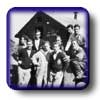Western Command
 On August 25, 1942,
Royal Canadian Air Force Squadron Leader K.A. Boomer shot down a Japanese
"Rufe" seaplane in an attack over the Japanese controlled
Kiska Island. It would be the only air victory of the Home
War Establishment, in one of the few instances of active
engagement with the enemy that took place in the Western
Command. On August 25, 1942,
Royal Canadian Air Force Squadron Leader K.A. Boomer shot down a Japanese
"Rufe" seaplane in an attack over the Japanese controlled
Kiska Island. It would be the only air victory of the Home
War Establishment, in one of the few instances of active
engagement with the enemy that took place in the Western
Command.
The action occurred as part of an American-led campaign
against the Japanese in the Aleutian Islands, off Alaska.
Earlier in the war the Japanese had taken control of two
islands in the Pacific, Kiska and Attu, as part of a larger strategic campaign
that included control of Midway Island. Unfortunately for
the Japanese, the Americans took Midway Island in 1942, diminishing the importance of Kiska and
Attu. The United States nevertheless wanted the two islands
back and requested the
aid of the Royal Canadian Air Force (RCAF) to achieve this objective.
 It
would be spring of 1943 before the Americans actually staged
a land invasion of the two islands. RCAF squadrons attacked
the islands in the lead-up to the invasion, bombing Japanese
installations and then conducting strafing runs. They supported
the land assault on Kiska, which Allied forces took
in three weeks. In July and August they turned to bombing
Attu, however stopped after discovering that they were only
bombing rocks, the Japanese having already left the island. It
would be spring of 1943 before the Americans actually staged
a land invasion of the two islands. RCAF squadrons attacked
the islands in the lead-up to the invasion, bombing Japanese
installations and then conducting strafing runs. They supported
the land assault on Kiska, which Allied forces took
in three weeks. In July and August they turned to bombing
Attu, however stopped after discovering that they were only
bombing rocks, the Japanese having already left the island.
 Bad
weather and old equipment were the biggest dangers for most
airmen flying in the Western Command. Several aircraft went
down during flights through deep fog that could extend hundreds
of miles from the coast. Western Canadian territory was
never in immediate danger of enemy attack, aside from a
few shells that hit a lighthouse on Vancouver Island in
1942, and incendiary
balloons, two of which were duly shot down by
RCAF patrols and which failed to cause a single Canadian
casualty. Bad
weather and old equipment were the biggest dangers for most
airmen flying in the Western Command. Several aircraft went
down during flights through deep fog that could extend hundreds
of miles from the coast. Western Canadian territory was
never in immediate danger of enemy attack, aside from a
few shells that hit a lighthouse on Vancouver Island in
1942, and incendiary
balloons, two of which were duly shot down by
RCAF patrols and which failed to cause a single Canadian
casualty.


|
 Heritage Community Foundation Presents
Heritage Community Foundation Presents Heritage Community Foundation Presents
Heritage Community Foundation Presents